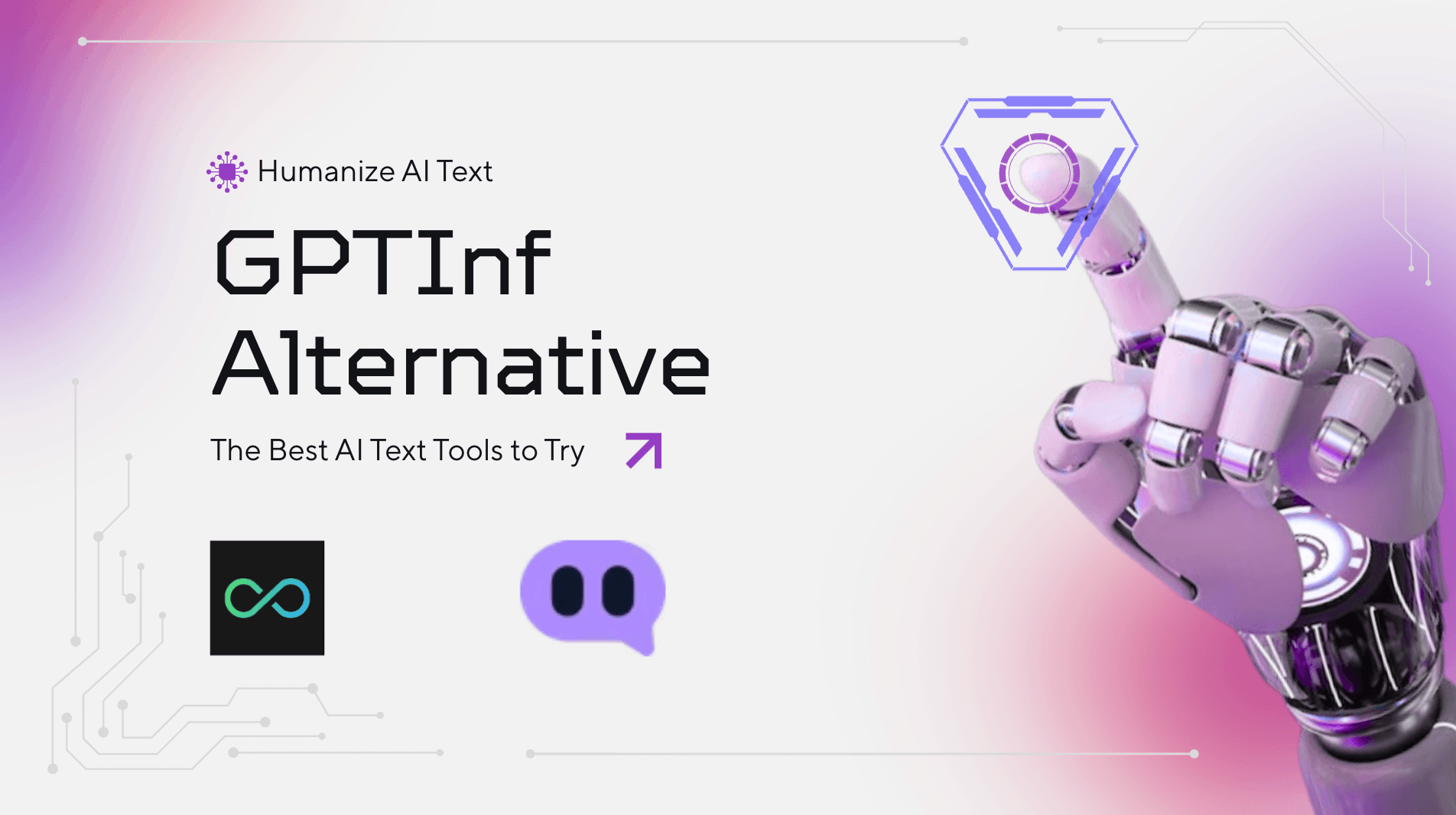In the fast-changing world of artificial intelligence, content generation has become easier than ever before. With tools like ChatGPT, writers, students, and professionals can produce large volumes of text quickly. However, this convenience comes with a new challenge — AI detection. Institutions, publishers, and online platforms now use advanced AI-detection systems to identify whether content is machine-generated.
One of the early solutions to this problem was GPTInf, a tool built to humanize AI-generated text and make it undetectable to AI detectors. Over time, it gained popularity among content creators, marketers, and students who wanted to retain the natural tone of their work while avoiding detection flags.
But as AI detectors evolve, GPTInf’s ability to stay ahead has been tested. Modern detectors such as GPTZero, Turnitin, and Originality.ai have become significantly more sophisticated, identifying even subtly generated AI content. That has left users searching for a reliable GPTInf alternative that offers better accuracy, smoother rewriting, and true human-like fluency.
This article takes a closer look at GPTInf, its capabilities, and its limitations — and explores why Humanize AI Text is emerging as the most suitable alternative for producing undetectable yet natural-sounding AI-assisted content.
What Is GPTInf and Why Did It Become Popular?
GPTInf was designed as an AI humanization tool, specifically targeting users who rely on large-language-model-generated text but want it to appear human-written. It analyzes linguistic patterns, sentence variety, and text predictability — the key factors that AI detectors use to spot machine-generated text.

GPTInf's Dashboard
By introducing stylistic noise, variation, and word randomness, GPTInf reshapes AI content to mimic human behavior in writing. For a long time, it worked effectively in beating common detectors like ZeroGPT and Sapling.
Key Features of GPTInf
• AI Detection Bypass: GPTInf’s primary feature is its ability to rewrite text so it passes AI-content detectors.
• Simple Interface: It allows users to copy and paste text directly into a web box and get results within seconds.
• Multiple Language Support: GPTInf supports several global languages, which makes it useful for multilingual writers.
• Fast Processing: It produces results in near real-time, which is attractive to users with tight deadlines.
Why Users Liked GPTInf
Initially, GPTInf gained attention for being one of the few tools capable of reliably bypassing detection at scale. Students could paraphrase essays, content creators could repurpose AI-written posts, and agencies could deliver client projects without red flags.
Its balance of simplicity and efficiency made it the go-to option for anyone seeking a quick way to make AI content undetectable. However, as AI detection algorithms improved, GPTInf started showing its age.
The Limitations of GPTInf
Even the best technology faces challenges when the ecosystem evolves. While GPTInf remains a functional tool, several users have observed certain limitations that make it less dependable in 2025.
1. Inconsistent Undetectability
New AI detectors now assess not just wording patterns but also semantic coherence, burstiness, and sentence probability. GPTInf’s rewrites sometimes fail these deeper checks. Texts may still be flagged, especially by Originality.ai or Turnitin, which now use hybrid AI + human linguistic analysis.
2. Loss of Meaning and Coherence
Many users report that while GPTInf successfully changes sentence structure, it occasionally distorts meaning. Some rewritten content reads awkwardly or loses context entirely — a serious issue for academic and professional writing.
3. Limited Customization
GPTInf provides minimal control over tone, readability, or intent. Users looking for SEO optimization or specific audience alignment must manually edit the output.
4. Outdated Algorithmic Model
As detectors evolve, GPTInf’s model has not kept pace. Newer tools employ adaptive rewriting engines that learn from the latest detector updates, something GPTInf currently lacks.
5. Quality Variance Across Languages
While GPTInf claims multilingual support, non-English outputs tend to be less accurate, producing unnatural phrasing or grammatical inconsistencies.
These challenges have prompted many to explore GPTInf alternatives — solutions capable of maintaining both human readability and detector evasion with superior reliability.
Why You Might Need a GPTInf Alternative
If you’re publishing, studying, or working in an environment that evaluates content authenticity, the need for a robust humanizer cannot be overstated. AI detectors now influence professional credibility, academic integrity, and even SEO rankings.
Below are a few key reasons why users are switching to newer, more advanced GPTInf alternatives:
1. Advanced AI Detectors Are Harder to Fool
Detection tools like Turnitin and GPTZero now incorporate probabilistic and neural network-based scoring systems. They can detect “over-optimized” randomness — something GPTInf often introduces.
2. Need for Higher Quality and Natural Flow
Writers today require content that not only bypasses detection but also reads smoothly. Some AI-rewritten texts sound artificial or lack emotional tone — a dealbreaker for marketing, blog writing, and social content.
3. SEO and Readability Concerns
Google’s algorithms prioritize clarity, coherence, and human engagement metrics. If a rewrite compromises quality, the text can lose ranking potential. Therefore, a modern gptinf alternative must maintain natural readability while bypassing detection.
4. Security and Privacy
As content humanizers process large volumes of data, users also want assurance that their uploaded text remains private and is not stored or reused. Many legacy tools, including older AI bypassers, fail to address this concern clearly.
5. All-in-One Flexibility
Users now demand more than a simple paraphraser. They need customization — tone control, creativity adjustment, audience targeting, and even domain-specific phrasing.
That’s where Humanize AI Text enters the picture — a next-generation platform designed to address each of these issues without compromising performance or privacy.
Meet Humanize AI Text: The Most Suitable GPTInf Alternative
Humanize AI Text has rapidly become one of the most trusted AI humanization tools available today. Built using advanced linguistic modeling and deep-learning refinement, it not only transforms AI-generated text into natural, human-sounding content but also preserves meaning, tone, and structure.
Unlike older systems that rely on random paraphrasing, Humanize AI Text applies contextual rewriting, meaning it understands sentence intent before rephrasing. This results in content that passes AI detectors while remaining smooth, logical, and professional.
How Humanize AI Text Works
Step 1: Input Your AI-Generated Text
Users can paste any AI-generated text — whether from ChatGPT, Bard, or Claude — into the Humanize AI Text editor.

Input Your AI-Generated Text
Step 2: Intelligent Context Analysis
The system identifies predictable sentence structures, statistical word patterns, and syntactic uniformity that detectors use to mark content as AI.

Intelligent Context Analysis
Step 3: Semantic Rewriting
Humanize AI Text rewrites content with varied sentence length, vocabulary richness, and human-like flow. Importantly, it maintains factual accuracy and tone consistency.

Semantic Rewriting
Step 4: Refinement for Readability
Finally, the algorithm ensures that the rewritten output reads naturally to human readers. It can adjust for tone — whether formal, academic, creative, or conversational.

Refinement for Readability
The outcome is content that looks, reads, and feels 100% human while remaining free from detection flags.
Key Features That Make Humanize AI Text Stand Out
1. High Accuracy Against Modern Detectors
Humanize AI Text is continuously updated to stay ahead of the newest AI detectors, including Originality.ai, Copyleaks, and Turnitin. It understands how each detector scores text and adjusts outputs to avoid predictable language patterns.
2. Human-Centric Linguistic Model
Rather than spinning words or injecting random phrases, Humanize AI Text mirrors natural human reasoning. It varies sentence rhythm, punctuation, and transitional flow — something AI detectors often miss but readers appreciate.
3. Tone and Audience Customization
From academic essays to marketing blogs, users can fine-tune the tone and complexity of output. This ensures contextual relevance and reader engagement, whether you’re addressing university faculty or online audiences.
4. Privacy and Data Protection
Humanize AI Text emphasizes data security. Your uploaded content is not stored or shared — a key advantage for professionals handling sensitive material.
5. Speed and Efficiency
The tool delivers results almost instantly, maintaining both efficiency and quality. Unlike GPTInf, which sometimes delays under high traffic, Humanize AI Text’s optimized servers ensure uninterrupted access.
6. SEO-Friendly Output
Writers and agencies appreciate that Humanize AI Text maintains SEO integrity. It retains keyword placement, avoids awkward phrasing, and supports readability optimization.
7. Ease of Use
Its minimal interface and one-click process make it accessible to anyone — from students to agencies and researchers.
Real-World Applications of Humanize AI Text
1. For Content Creators and Marketers
Humanize AI Text helps brands maintain authenticity while leveraging AI efficiency. Marketing agencies can create blog posts, newsletters, and ads that sound entirely human, enhancing engagement and trust.
2. For Students and Academics
Many institutions now rely on AI detectors to uphold academic integrity. Humanize AI Text enables students to refine drafts or summarize research while ensuring originality and natural tone.
3. For Businesses and Corporate Professionals
From reports to proposals, Humanize AI Text can turn machine-generated drafts into professional human-like documents suitable for business communication.
4. For SEO and Web Agencies
Since Humanize AI Text maintains SEO consistency, agencies can safely produce AI-assisted web content without risking ranking penalties.
5. For Copywriters and Freelancers
Freelancers benefit from faster delivery without sacrificing originality. The ability to humanize AI drafts streamlines productivity and client satisfaction.
Why Humanize AI Text Is a Suitable GPTInf Alternative
When analyzing the performance of GPTInf and Humanize AI Text side-by-side, several defining differences emerge:
- Detection Evasion Rate: Humanize AI Text consistently outperforms GPTInf in evading top AI detectors.
- Text Naturalness: Outputs from Humanize AI Text show superior coherence and stylistic flow.
- User Control: GPTInf’s one-style output model cannot adjust for tone or audience, whereas Humanize AI Text gives full flexibility.
- Consistency: GPTInf occasionally introduces grammatical errors or stilted phrases; Humanize AI Text produces balanced, polished results.
- Ongoing Development: Humanize AI Text evolves with AI detection algorithms, ensuring continuous reliability.
These combined strengths make Humanize AI Text not just a temporary alternative, but a long-term solution for sustainable AI-assisted writing.
How to Get the Most Out of Humanize AI Text
1. Refine Before Humanizing
Always ensure your AI-generated draft is complete and contextually sound before running it through the humanizer. This maintains clarity.
2. Choose Appropriate Tone
If you’re preparing academic content, opt for a formal tone. For blog or marketing copy, select a conversational tone.
3. Combine With Editing
Although Humanize AI Text produces high-quality results, a brief manual review further ensures precision.
4. Use for Multi-Purpose Content
You can reuse the tool for rewriting essays, improving SEO copy, summarizing content, or preparing reports.
5. Stay Updated
Since Humanize AI Text frequently updates its algorithm, visiting the platform regularly ensures access to the newest detection-resistant technology.
The Future of AI Text Humanization
As AI systems grow smarter, so do AI detectors. The arms race between generators and detectors will continue to define the content industry. The next generation of humanizers will rely less on randomization and more on cognitive emulation — replicating human reasoning and stylistic unpredictability rather than syntactic change alone.
Humanize AI Text represents this next step. Its model is dynamic, context-aware, and capable of identifying the emotional tone behind sentences — an ability that sets it apart from mechanical paraphrasers like GPTInf.
For writers, this means a future where machine assistance and human creativity can coexist seamlessly without fear of detection flags or loss of authenticity.
Final Thoughts
While GPTInf deserves credit for pioneering AI-text humanization, its limitations have become more apparent in today’s competitive detection environment. Users now demand more — realism, readability, reliability, and reassurance of privacy.
Humanize AI Text delivers on all fronts. It doesn’t just tweak language patterns; it recreates human thought flow, ensuring that every sentence feels authentic and spontaneous. Its adaptive learning model ensures resilience against constantly evolving detectors.
For professionals, students, and businesses looking for a reliable GPTInf alternative, Humanize AI Text is the clear winner. It bridges the gap between AI speed and human quality, offering a perfect blend of precision and creativity.
👉 Try Humanize AI Text today and transform your AI-generated content into natural, undetectable human writing — effortlessly and safely.
Frequently Asked Questions About GPTInf Alternatives
1. What is GPTInf, and why do people look for alternatives?
GPTInf is a tool that rephrases AI-generated content to bypass AI detectors. While effective initially, it struggles against advanced detection systems that analyze deeper linguistic patterns. As a result, users seek GPTInf alternatives like Humanize AI Text that provide higher success rates and smoother readability.
2. How does Humanize AI Text compare to GPTInf?
Humanize AI Text employs a more advanced algorithm that focuses on context, tone, and sentence rhythm rather than random word replacements. It produces text that not only passes AI detectors but also sounds naturally human, making it more reliable for academic and professional use.
3. Can Humanize AI Text guarantee undetectable results?
No tool can guarantee 100% invisibility across all detectors, but Humanize AI Text consistently delivers the highest success rates among existing solutions. Its adaptive system is designed to stay ahead of detection updates and generate content that is virtually indistinguishable from human writing.
4. Is Humanize AI Text safe and private?
Yes. Humanize AI Text prioritizes privacy. All uploaded content is processed securely and deleted after use, ensuring no data retention or third-party sharing.
5. Can I use Humanize AI Text for SEO-based content?
Absolutely. Unlike random paraphrasers, Humanize AI Text maintains keyword integrity and sentence flow. This makes it ideal for blog posts, product descriptions, and web pages that require natural language with search-engine compatibility.
6. How does Humanize AI Text handle different writing styles?
Users can customize tone, complexity, and style — from academic and technical to casual and conversational. This flexibility helps tailor the text to its intended audience while keeping it detection-free.
7. Is Humanize AI Text suitable for students?
Yes. Students can use it to refine AI-assisted drafts, summaries, or essays without losing originality. It enhances writing fluency while maintaining authenticity.
8. How often is Humanize AI Text updated?
The platform’s algorithm is updated regularly to adapt to new detection mechanisms. This ensures it remains effective against evolving tools like Turnitin, Copyleaks, and GPTZero.
9. Does it require a subscription or pay-per-use model?
Humanize AI Text offers flexible access options suitable for both casual and professional users. Its pricing is transparent and competitive compared to legacy tools like GPTInf.
10. What makes Humanize AI Text the best GPTInf alternative overall?
Its context-aware rewriting, adaptive updates, privacy focus, and natural linguistic flow make Humanize AI Text a complete upgrade over GPTInf. It bridges the gap between quality writing and AI efficiency, delivering human-like precision every time.


